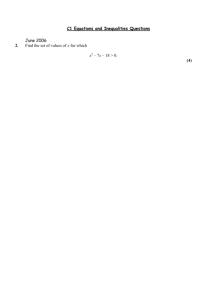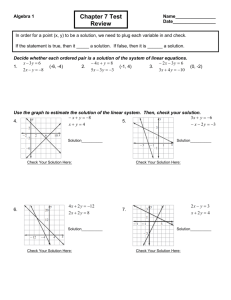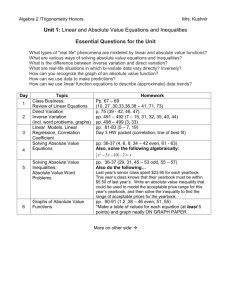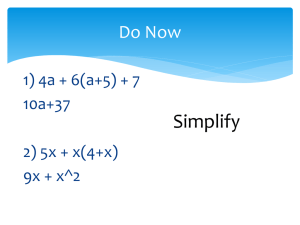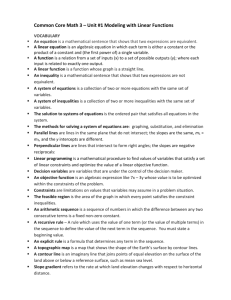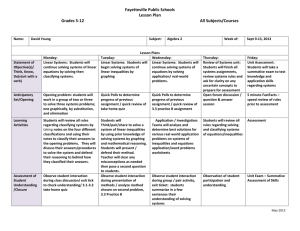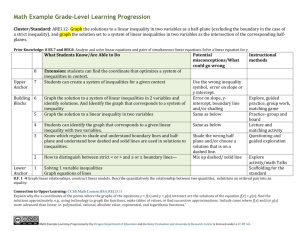UNIT1 Basics of ALG1 Study Guide
advertisement
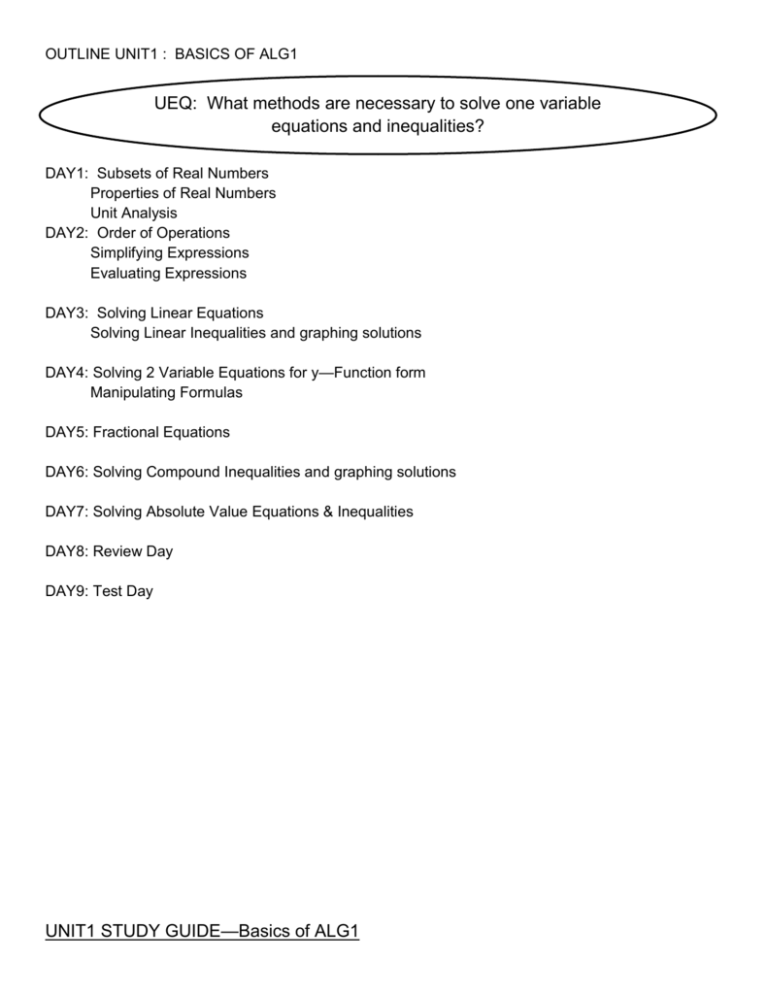
OUTLINE UNIT1 : BASICS OF ALG1
UEQ: What methods are necessary to solve one variable
equations and inequalities?
DAY1: Subsets of Real Numbers
Properties of Real Numbers
Unit Analysis
DAY2: Order of Operations
Simplifying Expressions
Evaluating Expressions
DAY3: Solving Linear Equations
Solving Linear Inequalities and graphing solutions
DAY4: Solving 2 Variable Equations for y—Function form
Manipulating Formulas
DAY5: Fractional Equations
DAY6: Solving Compound Inequalities and graphing solutions
DAY7: Solving Absolute Value Equations & Inequalities
DAY8: Review Day
DAY9: Test Day
UNIT1 STUDY GUIDE—Basics of ALG1
LEQ1: How are the properties of Real Numbers used in simplifying expressions?
DAY1:
LEQ2: What is the unit analysis approach to converting values?
(1.1; pg 3) SUBSET OF REAL NUMBERS
Define each Subset of Real Numbers:
~Whole Numbers:
~ Integers:
~ Rational Numbers:
Numbers that can be written as ___________________________.
When written as decimals, they _______________ or _______________.
~Irrational Numbers: Numbers that CANNOT be written as __________________________, such as
_____ or ____.
When written as decimals, they DON’T _______________ or
__________________.
EX1:
Classify the Number and them on the number line.
a)
2
b)
2
3
c) 0
d) -3
(1.1; pg5) PROPERTIES OF REAL NUMBERS: Study the examples in the book and summarize each
property below.
1. The Commutative Properties deal with___________________________.
2. The Associative Properties deal with ___________________________.
3. The Identity Property for Addition states that you can add _____________ to any value and not change
it.
4. The Identity Property for Multiplication states that you can multiply by _____________ and not change a
value.
5. The Inverse Property of Addition states that when you add _____________________ you get
_________.
6. The Inverse Property of Multiplication states that when you multiply ____________________ you get
EX2:
Justify each step:
_________.
6 – 3(x + 2)
Initial Expression
6 + - 3( x + 2)
____________________________
6 + - 3x + - 6
____________________________
- 3x
____________________________
7. The Distributive Property deals with which 2 operations?
+ 6 + -6
- 3x
+ (6 +
- 3x
+0
- 6)
- 3x
____________________________
____________________________
____________________________
(1.1) UNIT ANALYSIS/CONVERSION:
EX: Analyze the labels of each expression.
50 miles
75 miles
1 hour
A. (1.5 hours )
B.
24 dollars
$8 / hr 8 dollars per hour
3 hours
C. Convert 300 pesos into dollars if 8.5 pesos = $1
EXAMPLES:
3. What label would be left after the
following:
operation is performed?
dollars
4. EX: Use the conversion factor is 6 francs = $1to convert the
A. $500 into francs
B. 500 francs into
HW PROBLEMS: DO pg 7 #8-14, 33-38, 51-54 in the space below
DAY2
LEQ: How is the order of operations applied in evaluating & simplifying expressions?
(1.2; pg11) EXPONENTS & ORDER OF OPERATIONS
In the expression 25:
~the 2 is called the __________.
~ the 5 is called the ____________ and represents the number of times the base is used as a
_________.
~ the expression is called a ____________.
State the ORDER OF OPERATIONS:
~P
~E
~ MD
~AS
EX: {[−16 −(−2 + 1)] × 2} ÷ 5
{[−16 −(−1)] × 2} ÷ 5
{[−16 + 1] × 2} ÷ 5
{−15 × 2} ÷ 5
-30 ÷ 5
-6
Examples on next page.
EXAMPLES: Simplify each expression.
5. 6 +(7 + 2) ÷ 3
6. −4 −(1−5) −(−4)2
24
7. −3 – 2(−3−1)
8. (-2)4
9. -24
10. 4 –
(1.2 pg12-13) SIMPLIFYING EXPRESSIONS--COMBINING LIKE TERMS
Review these basic Vocab Terms: variable, like terms, coefficient, constant term
1. TERMS are separated by __________________________.
2. FACTORS are separated by __________________________.
3. To add like terms, add the __________________________________of those terms.
4. What is the difference between numerical expressions and algebraic expressions?
EX: Simplify each expression.
A. 10n− 4n
2y(y – 3)
B. −9 −6(−v+ 5)
6n
C. − 8x −10(−8x+ 9)
D. 3y2 +
- 8x + 80x – 90
72x – 90
3y2 + 2y2 – 6y
5y2 – 6y
-9 + 6v – 30
6v – 9 – 30
6v - 39
EXAMPLES: Simplify—combine like terms.
11. 1 + 4(2 − 3k)
12. −8v2 + 6(10 + 6v2)
14. −10(x− 7) −7(x+ 2)
13. 7(1 + 9v) −8(−5v− 6)
15. −2(−6x2− 9) − 4(x2 + 9)
16. 9y(7y + 8) + 3y(y − 10)
EVALUATE EACH EXPRESSION—Study the following examples.
EX: Evaluate each expression for the given values of the variables.
A. 4x + 3y; x = 3, y = -4
4(3) + 3(-4)
12 + -12
B.
b2-
4ac ; a = 3, b =- 4, c = -2
(-4)2 – 4(3)(-2)
16 - 4(3)(-2)
C.
x 2 2
3x 2 y
3 22
3(3) 2(1)
12
; x = -3, y = -1
EXAMPLES: Evaluate each expression for the given values of the variables.
17. 3x – 2y ; x = -2, y = -4
18. b2 - 4ac ; a=-2, b = 3, c = 1
19. b2 - 4ac ; a=-3, b = -5, c = -3
20. 2x2 – 3x + 4; x = -2
21. 10x – 9y; x
2
1
,y
5
3
22.
3 y 3x
; x = -1, y = 3
4( x 2 y )
HW: Finish the examples; pg 14 20-23, 32,37,43, 48, 50, 52
OTHER PRACTICE (if needed): pg 14 27-31,38,41,45-51
DAY3
Solving Linear Equations and Inequalities:
LEQ1: How are the Properties of Equality used to solve equations and manipulate formulas? (1.3,1.4)
LEQ2: How are one-variable inequalities solved and graphed? (1.6 goa1)
(1.3; pg19) SOLVING LINEAR EQUATIONS
1. A linear equations is in the form__________________.
2. A solution is a
_________________________________________________________________________.
3. The PROPERTIES OF EQUALITY can be summarized by saying:
PROBLEMS: Solve each equation. (you don’t need to state the properties, but think about them)
1. 75 = 3(−6n − 5)
2. −3( 1 + 6 r) =14 –r
3. 6(6v + 6) − 5 =1 +6v
4. 4x – (5 – 3x) = 9
5. 3(x – 2) – (3 – x) = 4x – 9
6. 12(2k + 1) =12(2k + 2)
(1.6; pg 41) SOLVING LINEAR INEQUALITIES
1. A linear inequality is solved similarly to a linear equation. The properties that allow you to solve
inequalities are called the Properties of Inequality.
2. When solving inequalities, you must switch the direction of the inequality symbol when you
________________or _________________ by a negative number.
3. When graphing solutions of inequalities…
~a closed circle should be used for _____ or ______ to indicate that the
endpoint __________________________________________________.
~an open circle should be used for _____ or ______ to indicate that the
endpoint __________________________________________________.
EX: Solve and Graph: 4x – 4 > 2x
-4 > -2x
Subt. Prop. of Ineq.
EXAMPLES: Solve each inequality and graph the solution.
7. 4n − 2n < 4
8. −12 < 2 + 5v + 2v
9. 6 > −3(x + 2)
10. Is -3 a solution to 3x + 2 < -7? Why or why not?
11. What does -1< x < 2 mean? What does it look like graphically?
12. Rewrite each of the following inequalities so the variable is first. (Symmetric Property of
Inequality)
a. 3 < x
b. -2 > x
c. 4 > x
HW: pg 22 23-31odd; pg 45 21,23,27-36M3
DAY4
Solving Linear Equations and Inequalities:
LEQ: What does it mean to put an equation in function form?(1.4)
(1.4; pg 26) REWRITING EQUATIONS –SOLVING (2-Variable Equations) FOR y
When an equation is solved for ‘y’, it is said to be in FUNCTION FORM.
*The main purpose of this form, for you, is to graph lines, but there are other uses.
STUDY THE FOLLOWING EXAMPLES. Think about the properties that were used to manipulate the
equation.
Solve equations A&B for y.
A. 4x – 2y = 8
B. 3(x – y) = 2x + 4
C. For parts A&B, find the value
of
-2y = -4x + 8
3x – 3y = 2x + 4
y when x = 3
y = 2x – 4
-3y = - x + 4
y
1
4
x
3
3
EXAMPLES: Solve each of the following 2 variable equations for y. Then determine the value of y
when x = 2.
13. 4x + 2y = 8
14. 6 = 3x – 2y
15. 3 – 5y = 8 – 10x
16. y – 2 = 3(x + 4)
(1.4; pg 28) MANIPULATING FORMULAS
A FORMULA is an equation with more than one variable.
STUDY THESE EXAMPLES: Solve each formula for the given variable.
A.A l w ; for w
B. P 2l 2 w ; for l
A lw
l
l
A
w
l
EXAMPLES:
17. Solve A = ½ bh for ‘h’
DAY5
P 2 w 2l
P 2 w 2l
2
2
P
wl
2
18. Solve P = 2L + 2W for ‘W’
CW: pg 29 #4-9,13,15,24-28
PracticeFractional/Decimal
WS
Solving
Equations
19. Solve A = π r2 for ‘r’
HW:
LEQ: How do you solve equations containing fractions or decimals?
FRACTIONAL/DECIMAL EQUATIONS
***To solve equations containing fractions:
clear fractions by multiplying both sides of the equation by the LCD.
Essentially, this means that EVERY
TERM on both sides will be multiplied by the LCD.
***To solve equations containing decimals:
clear decimals by multiplying both sides of the equation by a power of 10
that makes all coefficients integers.
1
1
1
x x
3
4
6
1
1
1
12 x 12 x
4
6
3
1
1
1
12 x 12 12 x 12
3
4
6
4 x 3 12 x 2
8 x 3 2
8 x 5
5
x
8
EXAMPLES:
1
1
EX: x 2
3
2
2
3.01( x 2) 2.2 1.01x
x 1 3 x 2
3
5
100 3.01( x 2) 2.2 100 1.01x
2
3
15 x 1 15 x 2 100 3.01( x 2) 100 2.2 100 1.01x
3
5
301( x 2) 220 101x
2
3
301x 602 220 101x
15 x 1 15 x 15 2
3
5
301x 822 101x
5 2( x 1) 3 3 x 30
822 200 x
10( x 1) 9 x 30
4.11 x
10 x 10 9 x 30
x 4.11
x 10 30
x 40
EX:
2
5
x 2
3
2
EX: 0.2x - 0.04 = x
Use Fractional/Decimal Equation WS also
DAY6 (1.6; pg43) COMPOUND INEQUALITIES
LEQ: What are the two types of compound inequalities and how are solutions to each graphed? (1.6 goal2)
Compound Inequalities are joined by the words ________or _____;
therefore, there are _________ ‘conditions’ on the variable.
The compound inequality containing the
word AND is called a
________________________.
The compound inequality containing the
word OR is called a
__________________________.
The solution to this compound inequality is
found by taking the _____________________
of the graphs.
EX: x > -2 AND x < 4
The solution to the compound inequality is
found by taking the _____________________
of the graphs.
EX: x > 3 OR x < -1
EXAMPLES: Solve each of the following compound inequalities. A graph may be helpful in stating the
solution.
1. -9 < 2x – 3 < 7
2. 4x – 2 < 2 OR 2x – 3 > 3
3. 3 < 4x + 7 < 7
SPECIAL CASES:
1. x > 2 AND x < -2
4. 2x + 4 < -6 OR 3x > 7
2. x > -2 AND x >2
3. x < 2 OR x > -2
4. x > 2 OR x > -2
HW:
DAY7
1.7 Solving and Graphing Absolute Value Equations and Inequalities
LEQ: How do we solve and graph absolute value equations and inequalities? (1.7)
ABSOLUTE VALUE
The absolute value of a number is
_______________________________________.
WHAT DO EACH OF THESE STATEMENTS
MEAN?
|x|<3
|x|=3
SUMMARY:
1. There are _____ cases for every absolute value statement.
2. For equations, use the word _______ and find the cases by…
Case1:
|x|>3

